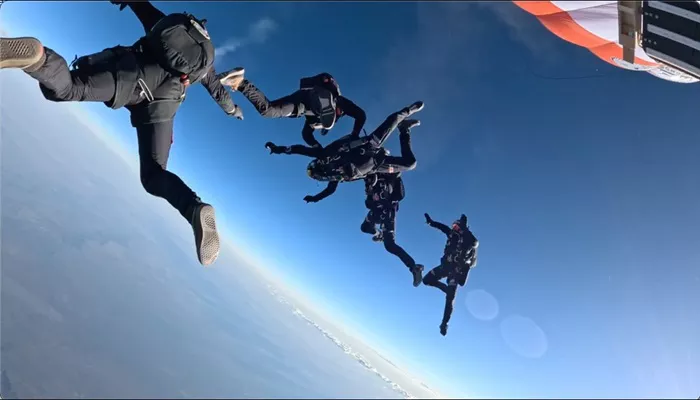Halo Jumps (High Altitude, Low Opening) are one of the most exhilarating and technically demanding forms of skydiving. Originating from military applications, this extreme sport has gained popularity among skydiving enthusiasts for its thrill and challenge. A Halo Jump involves exiting the aircraft at a high altitude, usually between 15,000 and 35,000 feet, and freefalling until a very low altitude before deploying the parachute. This article serves as a comprehensive guide for beginners, outlining everything you need to know to prepare for your first Halo Jump. Whether you’re new to skydiving or a seasoned jumper looking to take your skills to the next level, this guide will provide you with essential information to help you succeed.
What Is A Halo Jump?
A Halo Jump is a specialized form of skydiving that typically involves exiting an aircraft at a very high altitude, allowing the diver to experience an extended freefall before deploying the parachute at a low altitude. The goal is to minimize the parachute’s exposure time to the air, making it a challenging and adrenaline-pumping experience. HALO jumps are typically used by military personnel for tactical operations but have also become a popular extreme sport among adventure seekers.
The Difference Between Halo Jumps and Regular Skydiving
One key difference between Halo Jumps and regular skydiving is the altitude at which the jump occurs. While most standard skydives happen at around 10,000 to 14,000 feet, a Halo Jump typically involves altitudes between 15,000 and 35,000 feet.
This high-altitude exit requires special equipment, including oxygen masks for high-altitude jumps, and precise timing to ensure a safe deployment of the parachute. Moreover, Halo Jumps are executed in specific conditions that are vastly different from regular skydiving, making them much more challenging.
Essential Gear for Halo Jumps
Halo Jumps require specific gear to ensure safety and performance during the jump. Unlike traditional skydives, the higher altitude necessitates extra precautions such as oxygen masks and specialized jumpsuits. Here’s a breakdown of the essential gear:
Oxygen Mask: For jumps above 15,000 feet, supplemental oxygen is required to prevent hypoxia.
Jumpsuit: A well-fitted, durable jumpsuit helps manage wind resistance and protects the jumper from the cold at high altitudes.
Parachute: The main parachute must be equipped with a ripcord, and many jumpers use an automatic activation device (AAD) as a backup safety feature.
Altimeter: This device is used to monitor altitude and ensure the parachute is deployed at the right height.
Helmet and Goggles: To protect the head and eyes from wind and debris during freefall.
How to Prepare for Your First Halo Jump
Before attempting a Halo Jump, it is crucial to undergo extensive training to understand the risks and techniques involved.
Here are the steps to prepare for your first jump:
1. Basic Skydiving Training
If you are new to skydiving, you will need to complete basic skydiving training first. This involves a series of tandem jumps, where you are strapped to an instructor who guides you through the process. This initial training will help you gain confidence and understand how to handle the freefall and parachute deployment. Most skydiving schools require a minimum of 25 jumps before you’re allowed to attempt more advanced maneuvers like a Halo Jump.
2. Special HALO Jump Training
After mastering basic skydiving techniques, you’ll need to complete specialized training for Halo Jumps. This includes learning about the high-altitude environment, the effects of low oxygen, and the precise timing needed for deploying the parachute. Training will also cover emergency protocols in case of malfunctions.
3. Understand the Risks
Halo Jumps are inherently riskier than standard skydives due to the high altitude and the need for precise timing. Ensuring you’re fully aware of these risks and knowing how to handle emergency situations is a critical part of the preparation. You should be physically fit and mentally prepared for the challenges of high-altitude jumps.
What to Expect During a Halo Jump
Once you’re ready to take on your first Halo Jump, it’s essential to know what to expect. Here’s a breakdown of the jump sequence:
1. Pre-Jump Briefing
Before the jump, the instructor will go over the details, including your exit procedure, freefall technique, and parachute deployment. You will also go through emergency protocols in case of a problem during the jump. The briefing is crucial to ensure everyone is on the same page, as timing is extremely important.
2. Aircraft and Altitude
For a Halo Jump, the aircraft typically ascends to an altitude between 15,000 and 35,000 feet. You will need to wear an oxygen mask as you approach the jump altitude to prevent hypoxia, which occurs when the body doesn’t get enough oxygen at high altitudes.
3. The Jump
Once at the right altitude, you will exit the aircraft and begin freefalling. During the freefall, you will be falling at speeds of up to 120 miles per hour, which can feel intense but thrilling. Depending on the altitude, you may freefall for several minutes before deploying your parachute at a lower altitude.
4. Parachute Deployment
The critical part of a Halo Jump is ensuring the parachute is deployed at the right altitude. If done properly, you will experience a smooth and controlled descent to the ground. An automatic activation device (AAD) is often used as a backup to deploy the parachute in case the jumper is incapacitated or forgets to deploy it manually.
Conclusion
Halo Jumps are a thrilling, high-adrenaline activity that offers an intense skydiving experience. With the right training, gear, and mindset, you can safely enjoy this extreme sport. Whether you’re looking to push your limits or add a new challenge to your skydiving portfolio, a Halo Jump is an unforgettable experience. Always remember to prioritize safety and work with experienced instructors to ensure your jump goes off without a hitch. For those who are ready, a Halo Jump offers a unique and exhilarating challenge that is well worth the preparation.

